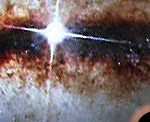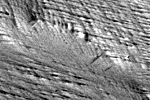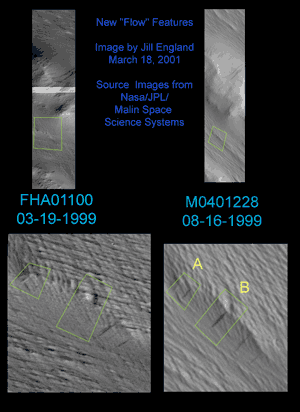


Hyperfaceted™
Discovery of Freshly Created
Martian Flow Features
March 18, 2001
Jill@Hyperfaceted.com (Jill England)
Discovery!
For almost a year, there has been a debate about the so-called flow or flow images on the surface of Mars. The intriguing possibility is that they are flows of water from sources beneath the surface happening as real water runoff today.
If the hypothesis that flows represent current water flow features is true, then it should be possible to see new ones form and old flows change and disappear.
If on the other hand flows can be shown to be persistent and unchanging then they are presumably longer lived features and there is no current activity to generate them.
Method
The method used in this image analysis will be to find overlapping images, if any, in the list of images of flows collected to date. Images found will have a time lapse and flow features can then be compared.
To identify images that are close to each other and possibly overlap a "Great Circle Distance" is calculated for every combination of images in the known flow image list.
When overlapping images are found they will need to have comparable resolutions and be of high enough resolution to discern surface features clearly.
Qualifying images can be compared to identify any flow feature changes such as new flows being created or old flows becoming invisible. Measurements of any such features should be calculated by multiplying the pixel resolution by the length (in pixels) of the artifact on the image. Note that distances calculated this way will only be estimates due to various combinations of hills and camera angles.
As a final part of the analysis a red/blue stereo picture should be created if possible.
Results
The list of images used in this comparison have already been identified to contain flow features. A copy of this image list may be found here.
The distances between each image and all the rest in the list above were calculated generating a report of over 6000 combinations. The top 100 closest matches are listed here.
Two overlapping images containing flows, FHA/01100 and M04/01228 have been identified. These two images were taken on March 19, 1999 and August 16, 1999 respectively. The images were taken 5 months apart. It is not believed that the seasons at this latitude change the climate substantially.
| Image Name | Image Time | Resolution meters/pixel |
Center Latitude |
Center Longitude |
Martian Season |
| FHA/01100 | March 19, 1999 | 1.44 | -8.34 | 155.05 | Early winter |
| M04/01228 | August 16, 1999 | 4.29 | -8.30 | 155.05 | Early spring |
Click on image names above to view original images at Malin Space Science Systems.
The images have comparable resolutions of 1.44 meters/pixel and 4.29 meters/pixel. The images are also clear and free from obscuring dust or clouds.
When the images were compared three New flows were discovered in the more recent image that had no counterpart in the older image. None of the older flows has noticeably changed. The three new flows are labeled A, B, and C in these pictures.
The lengths of the new flows found in M04/01228 are as follows:
| Flow Name | Flow Length | Approximate Length in Meters | |
 |
A | 11 pixels | 45 meters |
| B | 20 pixels | 84 meters | |
| C | 32 pixels | 139 meters | |
In comparison to the lengths of these three new flow features, the largest flow features in M04/01228 are approximately 890 meters long.
Conclusions
The following conclusions are drawn;
| 1. | Flows are "Long Lived" surface features that persist for more than 5 months. |
| 2. | Flows are very recent surface features forming at the present time on the Martian surface. |
| 3. | It seems obvious but it should be pointed out that new flow features appear very dark. Presumably they get lighter over time. Why they start out dark, why they get lighter, and what causes them to suddenly appear are questions that need to be answered. |
Further Study
Compare all images in the MOC database searching for other overlapping images containing flow features. This will give additional data and help formulate conclusions about what the flows are made of and how they are forming.
In many other images, faded flow patterns are clearly visible next to darker newer flows. Flow features appear to fade with time. How much time it takes for a flow to fade is a very interesting question and that information could possibly be used to draw conclusions about the creation process and creation rate of the flow features. A possible hypothesis is that flow features will appear in a steady state with old flows fading at the same rate that new flows are being created.
Since flow features are persistent for periods of time longer than Martian seasons it is unlikely that there will be any seasonal correlation between imaging time and seasons. The exercise should still be done however.
Count the number of flows in each image and plot the count against latitude to see if there is a smooth decline in flows as you move away from the equator. Preliminary analysis from Efrain Palermo strongly suggests that this is true.
On the wish list, it would be nice to stand in the middle of a flow and sample it. This would instantly answer many questions.
Acknowledgments
|
Jill England |
Custom unpublished software by Jill England, 2001. Said software uses Great Circle Equations from Bowditch, American Practical Navigator, Defense Mapping Agency Hydrographic Center, 1975, pp. 443 582-3. |
|
Richard Hoagland |
Who just doesn't get enough credit for initiating interest in Space Sciences. |
Efrain Palermo |
For his Web Site dedicated to Martian Flow features, large list of flow images, and analysis of flow image distributions. |
Nasa/JPL/Malin Space Science Systems |
For the images and databases. |
USGS-Flagstaff MGS-MOC Web Pages |
As an additional archive and access point for the Malin Space Science images and databases. |
Special thanks to Nasa/JPL/Malin Space Science Systems for their efforts in organizing and creating this data and most importantly making it's catalog and database available. Thank you so much, exploring Mars and making this discovery, whatever it may mean, has been an exciting and wonderful experience and is the closest I am every likely to get to exploring other worlds.
Thank you!
Disclaimers and Copyright
This paper is neither supported by nor associated with Nasa, JPL, or Malin Space Science Systems.
This paper was not produced for profit nor was any compensation of any sort provided by anyone for this paper's creation or distribution.
This paper is not produced for, supported by, or affiliated with either Richard Hoagland, The Enterprise Mission, or Art Bell.
This paper is Copyright(c) by Jill England, 2001. All rights reserved.
About the Author
Jill England graduated from the University of Puget Sound in Tacoma in 1984 with a degree in Computer Information Systems.
She makes her living creating software systems as a contract software engineer in Seattle Washington.

